Malabar rebellion
The Malabar Rebellion in 1921 started as resistance against the British colonial rule, the prevailing feudal system, and in favour of the Khilafat Movement[4] in South Malabar but ended in communal violence between Hindus and Muslims. These were a series of clashes between the Mappila peasantry and their landlords, supported by the British, throughout the 19th and early 20th centuries. The heavy-handed crackdown of the Khilafat Movement by the British Authorities was met by resistance in the Eranad and Valluvanad taluks of Malabar. In the initial stages, the movement had the support of Mohandas Gandhi and other Indian nationalist leaders, and a number of clashes took place between Khilafat volunteers and other religious communities, but the violence soon spread across the region.[5] The Mappilas attacked and took control of police stations, British government offices, courts and government treasuries.[6][7]
| Malabar Rebellion. | |||||||
|---|---|---|---|---|---|---|---|
| Part of the Khilafat Movement, the Mappila riots, and the Indian independence movement | |||||||
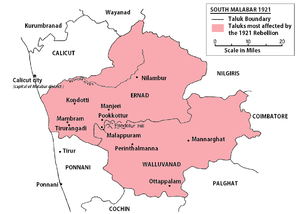 South Malabar in 1921; areas in red show Taluks affected by the rebellion | |||||||
| |||||||
| Belligerents | |||||||
| Mappila Muslims | ||||||
| Commanders and leaders | |||||||
|
Rufus Isaacs (Viceroy of India) Freeman Freeman-Thomas (Governor of Madras) Thomas T. S. Hitchcock A. S. P. Amu |
Ali Musliyar Variankunnath Kunjahammad Haji Sithi Koya Thangal M. P. Narayana Menon[1] Chembrasery Thangal K. Moiteenkutti Haji Kappad Krishnan Nair[2] Konnara Thangal Pandiyatt Narayanan Nambeesan[2] | ||||||
| Casualties and losses | |||||||
|
43 killed Civilians: |
2,339 killed 1,652 injured 45,404 imprisoned (British estimates) 50,000 imprisoned (Indian estimates) | ||||||
| Part of a series on the |
| History of Kerala |
|---|
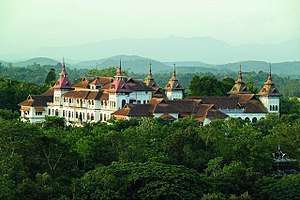 |
|
Main Megalithic culture Maritime contacts |
|
Other topics |
|
The British Government put down the rebellion with an iron fist. British and Gurkha regiments were sent to the area and Martial Law imposed.[8] One of the most noteworthy events during the suppression later came to be known as the "Wagon Tragedy", in which 67 out of a total of 90 Mappila prisoners destined for the Central Prison in Podanur suffocated to death in a closed railway goods wagon.[8] For six months from August 1921, the rebellion extended over 2,000 square miles (5,200 km2) – some 40% of the South Malabar region of the Madras Presidency.[9] An estimated 10,000 people lost their lives,[10] although official figures put the numbers at 2337 rebels killed, 1652 injured and 45,404 imprisoned. Unofficial estimates put the number imprisoned at almost 50,000 of whom 20,000 were deported, mainly to the penal colony in the Andaman Islands, while around 10,000 went missing.[11] The most prominent leaders of the rebellion were Variankunnath Kunjahammad Haji, Sithi Koya Thangal and Ali Musliyar.[10]
Contemporary British administrators and modern historians differ markedly in their assessment of the incident, debating whether the revolts were triggered off by religious fanaticism or agrarian grievances.[12] At the time, the Indian National Congress repudiated the movement and it remained isolated from the wider nationalist movement.[13] However, some contemporary Indian evaluations now view the rebellion as a national upheaval against British authority and the most important event concerning the political movement in Malabar during the period.[10]
In its magnitude and extent, it was an unprecedented popular upheaval, the likes of which has not been seen in Kerala before or since. While the Mappilas were in the vanguard of the movement and bore the brunt of the struggle, several non-Mappila leaders actively sympathised with the rebels' cause, giving the uprising the character of a national upheaval.[6] In 1971, the Government of Kerala[14] officially recognised the active participants in the events as "freedom fighters".[15] [16] [17]
Background
Land ownership in Malabar
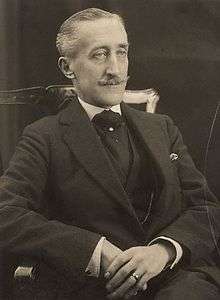
Malabar's agricultural system was historically based on a hierarchy of privileges, rights and obligations for all principal social groups in what British administrator William Logan sometimes referred to as the "Father of Tenancy Legislation" in Malabar,[18] describing it as a system of 'corporate unity’ or joint proprietorship of each of the principal land right holders:[19][20]
Jenmi
The Jenmi, consisting mainly of the Namboothiri Brahmins and Nair chieftains, were the highest level of the hierarchy, and a class of people given hereditary land grants by the Naduvazhis or rulers'. The rights conveyed by this janmam were not a freehold in the European sense, but an office of dignity. Owing to their ritual status as priests (Nambudris), the jenmis could neither cultivate nor supervise the land but would instead provide a grant of kanam to a kanakkaran in return for a fixed share of the crops produced. Typically, a Jenmi would have a large number of kanakkarar under him.
Verumpattakkaran
The Verumpattakkarar, generally Thiyya and Mappila classes, cultivated the land but were also its part-proprietors under the kanakkarar. These classes were given a Verum Pattam (Simple Lease) of the land that was typically valid for one year. According to custom, they were also entitled to one-third or an equal share of the net produce.
The net produce of the land was the share left over after providing for the cherujanmakkar or all the other birthright holders such as the village carpenter, the goldsmith and agricultural labourers who helped to gather, prepare and store produce. The system ensured that no Jenmi could evict tenants under him except for non-payment of rent. This land tenure system was generally referred to as the janmi-kana-maryada (customary practices).[19][20]
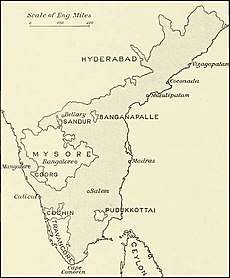
Land reforms and Mappila outbreaks (1836–1921) – Theory of class conflict
During the Mysorean invasion of Malabar, the Jenmi took refuge in neighbouring states. The tenants and the Nair army men who could not escape were converted into Islam, as described in William Logan's Malabar Manual. Thus, Tipu Sultan's Kingdom of Mysore, having driven the Jenmi out of Malabar, reached accord with the Muslim Kanakkars. A new system of land revenue was introduced for the first time in the region's history with the government share fixed on the basis of actual produce from the land.[21]
However, within five years, the British took over Malabar, defeating Tipu Sultan and ending his reign over the region. This allowed the Jenmi to return to their homes and regain the lands lost during the Mysorean invasion, with the help of the British government and its duly-constituted courts.[22] The British superimposed several Western juridical concepts, such as that of absolute property rights, upon the existing legal system of Malabar. Up until then, such rights had been unknown in the region and as a result all land became the private property of the Jenmi. This legal recognition gave them the right to evict tenants, which was in turn enforced through the British civil courts.[20][21] In the words of William Logan:
The (British) authorities, recognised the Janmi as absolute owner of his holding, and therefore free to take as big a share of the produce of the soil as he could get out of the classes beneath him... (Gradually) The British Courts backed up by Police and Magistrates and troops and big guns made the Janmi's independence complete. The hard terms thus imposed on the Kanakkaran had, of course, the effect of hardening the terms imposed by the Kanakkaran on those below him, the Verumpattakkar. The one-third of the net produce to which the Verumpattakkaran was customarily entitled, was more and more encroached upon as the terms imposed on the Kanakkaran became harder and harder. (Government of Madras. 1882, Vol. I: xvii, xxxi–ii)
As conditions worsened, rents rose to as high as 75–80% of net produce, leaving the Verumpattakkar cultivators largely "only straw".[21] This caused great resentment among the Mappilas, who, in the words of Logan, were "labouring late and early to provide a sufficiency of food for their wives and children".[20] General resentment amongst the Muslim population led to a long series of violent outbreaks beginning in 1836. These always involved the murder of Hindus, an act which the disgruntled Mappilas regarded as religiously meritorious and as part of their larger obligation to establish an Islamic state. In 1921, for instance, the stated aim was not simply to oust the Jenmi system, but to establish an Islamic nation in Malabar.[9] The British administration referred to the outbreaks as "Moplah outrages", but modern historians tend to treat them as religious outbreaks[23] or expressions of agrarian discontent.[24] The massacre of Hindus and widespread sexual violence in 1921–22 sustained this tradition of violence in Malabar but with one crucial difference: this time it had also a political ideology and a formal organisation.[14][5][19]
Khilafat Movement
Diwan Bahadur C. Gopalan Nair in his book, 'The Moplah Rebellion 1921',[25] writes thus:
...it was not mere fanaticism, it was not agrarian trouble, it was not destitution, that worked on the minds of Ali Musaliar and his followers. The evidence conclusively shows that it was the influence of the Khilafat and Non-co-operation movements that drove them to their crime. It is this which distinguishes the present from all previous outbreaks. Their intention was, absurd though it may seem, to subvert the British Government and to substitute a Khilafat Government by force of arms.(Judgement in Case No. 7 of 1921 on the file of the Special Tribunal, Calicut.) ...
Nair noted Ali Musliyar rose to prominence at the instance of a Khilafat conference held in Karachi. Furthermore, Musliyar was not a native of Tirurangadi. He had only moved in 14 years earlier. So, according to Nair, there was not class revolt he was handling. It was a Khilafat edifice prepared and passed from distant Karachi, possibly controlled by spiritual leaders of Islam.[26]
The Khilafat movement was introduced into the district of Malabar on 28 April 1920, by a Resolution at the Malabar District Conference, held at Manjeri, the headquarters of Ernad Taluk. On 30 March 1921, there was a meeting at which one Abdulla Kutti Musaliar of Vayakkad lectured on Khilafat, in Kizhakoth Amsom, Calicut Taluk. And at a second meeting held the next day at Pannur Mosque, there was some unpleasantness between the Mappilas on one side, and Nairs and Tiyyar, who resented the Khilafat meeting, on the other. The Mappilas mustered the strength to attack the place of worship belonging to the Hindu Adhigari of the village.[26]
Nature of crimes
The Malabar Rebellion witnessed many attacks on the British officers. The Madras High Court, which adjudicated in this matter, had passed judgements on each of the cases against the various Mappila rioters who were captured.[27] The Madras High Court said on the matter,
It appears also that on the night of the 20th of August, at Nilambur 16 miles from Manjeri a police constable at Edavanna, were murdered and at Tiruvangadi in addition to Mr. Rowley and Lieutenant Johnston nine other persons were murdered. The police station at Manjeri was attacked on the night of the 21st; public officers at Manjeri on the 22nd. On the 24th of August Variyamkunnath Kunhahammad Haji who is described as the rebel leader arrived at Manjeri. All these incidents had occured [sic] when the respondent made the speech already referred to, and it was in such dangerous surroundings that he made it and the reference to Tiruvangadi in that speech has a consequence, a particular significance. Subsequent events are that on the 26th of August a retired police inspector was murdered at Anakayam near Manjeri by Variyamkunnath Kunhahammad Haji and his followers and on the 25th of August his head was paraded on a spear; and it was common ground that the respondent was at Manjeri from the morning of the 21st of August until the 30th of August.
The District Magistrate stated that reliable information had been received about 180 forced conversions of Hindus and the actual total may run into thousands.[28] Roland E. Miller estimates forced conversions as in the range of 200 and 2500.[29] In the aftermath of this ethnic cleansing, the Suddhi Movement was created by the Arya Samaj. They converted over 2,000 Hindus who had been forcibly converted to Islam by the Mappilas. However, their leader, Swami Shraddhananda was stabbed on 23 December 1926 by an Islamist at his Ashram.
Punishments of rebel leaders
The following were the various leaders of the movement, who were sentenced to death following the Malabar Rebellion:[30]
- Ali Musliyar, leader of the rebellion
- Kunhi Kadir, Khilafat Secretary, Tanur
- Variankunnath Kunhammad Haji
- Kunhj Koya, Thangal, President of the Khilafat Committee, Malappuram
- Koya Tangal of Kumaramputhur, Governor of a Khilafat principality
- Chembrasseri Imbichi Koya Thangal, notorious for his killing of 38 men by slashing their necks and throwing them into a well
- Palakamthodi Avvocker Musaliar
- Konnara Mohammed Koya Thangal
Rebellion and Response

On 20 August 1921, the police attempted to arrest Vadakkevittil Muhammed, the secretary of the Khilafat Committee of Ernad at Pookkottur, alleging that he had stolen the pistol of a Hindu Thirumulpad from a Kovilakam (manor) in Nilambur. A crowd of 2,000 Mappilas from the neighbourhood foiled the attempt, but on the following day, a squad of police arrested a number of Khilafat volunteers and seized records at the Mambaram Mosque in Tirurangadi, leading to rumours that the building had been desecrated. A large crowd of Mappilas converged on Tirurangadi and besieged the local police station. The police opened fire on the crowd, triggering a furious reaction which soon engulfed the Eranad and Valluvanad Taluks along with neighbouring areas and continued for over two months.[8]
Following the mosque incident, the rebels attacked and seized police stations, government treasuries, and entered the courts and registry offices where they destroyed records. Some even climbed into the judges' seats and proclaimed the advent of swaraj (self-rule). The rebellion soon spread to the neighbouring areas of Malappuram, Manjeri, Perinthalmanna, Pandikkad and Tirur under principle leaders Variankunnath Kunjahammad Haji, Seethi Koya Thangal of Kumaranpathor and Ali Musliyar. By 28 August 1921, British administration had virtually come to an end in Malappuram, Tirurangadi, Manjeri, and Perinthalmanna, which then fell into the hands of the rebels who established complete domination over the Eranad and Valluvanad Taluks. On 24 August 1921, Variankunnath Kunjahammad Haji took over command of the rebellion from Ali Musliyar. Public proclamations were issued by Variyankunnath and Seethi that those Mappilas who resorted to looting would receive exemplary punishments.[6]
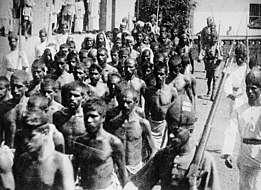
During the initial stages of the rebellion, the British military and police were forced to withdraw from these areas but by the end of August, several contingents of British troops and Gurkha arrived. Clashes with the rebels followed, one of the most notable encounters taking place at Pookkottur (often referred by Mappilas as Battle of Pookkottur), in which British troops sustained heavy casualties and had to retreat to safety.[6]
During the early phase of the rebellion, the targets were primarily the Jenmi and the British Government. Crimes committed by some of the rebels were accepted by leaders. After the proclamation of Martial law and the arrival of the British army, when some members of the Hindu community were enlisted by the army to provide information on the rebels.[6][7] Once they had eliminated the minimal presence of the government, the Mappilas turned their full attention to attacking Hindus while Ernad and Valluvanad were declared "Khilafat kingdoms".[31]
By the end of 1921, the situation was brought under control. The British administration raised a special quasi-military (or Armed Police) battalion, the Malabar Special Police, initially consisting of non-Muslims and trained by the British Indian Army. The Special Police then attacked the rioters and eventually subdued them.
Reactions and aftermath
B. R. Ambedkar said on the rebellion:[32]
The blood-curdling atrocities committed by the Moplas in Malabar against the Hindus were indescribable. All over Southern India, a wave of horrified feeling had spread among the Hindus of every shade of opinion, which was intensified when certain Khilafat leaders were so misguided as to pass resolutions of congratulations to the Moplas on the brave fight they were conducting for the sake of religion". Any person could have said that this was too heavy a price for Hindu-Muslim unity. But Mr. Gandhi was so much obsessed by the necessity of establishing Hindu-Muslim unity that he was prepared to make light of the doings of the Moplas and the Khilafats who were congratulating them. He spoke of the Mappilas as the "brave God-fearing Moplahs who were fighting for what they consider as religion and in a manner which they consider as religious ".
Annie Beasant recounts in two separate articles in New India on 29 November 1921 and 6 December 1921 as to what happened to the Malabar Hindus at the hands of the Moplahs:[33]
Mr. Gandhi…can he not feel a little sympathy for thousands of women left with only rags, driven from home, for little children born of the flying mothers on roads in refuge camps? The misery is beyond description. Girl wives, pretty and sweet, with eyes half blind with weeping, distraught with terror; women who have seen their husbands hacked to pieces before their eye, in the way “Moplas consider as religious”; old women tottering, whose faces become written with anguish and who cry at a gentle touch…men who have lost all, hopeless, crushed, desperate…Can you conceive of a more ghastly and inhuman crime than the murders of babies and pregnant women?…A pregnant woman carrying 7 months was cut through the abdomen by a rebel and she was seen lying dead on the way with the dead child projecting out of the womb…Another: a baby of six months was snatched away from the breast of his own mother and cut into two pieces… Are these rebels human beings or monsters?
A respectable Nayar Lady at Melatur was stripped naked by the rebels in the presence of her husband and brothers, who were made to stand close by with their hands tied behind. When they shut their eyes in abhorrence they were compelled at the point of sword to open their eyes and witness the rape committed by the brute in their presence.
Here is the text of Resolution No. 3 of the Ahmedabad session of the INC, where Gandhiji was appointed as its sole executive authority, on 24 December 1921, in connection with the Moplah Riots:[34]
The Congress expresses its firm conviction that the Moplah disturbance was not due to the Non-Co-operation or the Khilafat movement, especially as the…Khilafat preachers were denied access to the affected parts by the District authorities for six months before the disturbance, but is due to causes wholly unconnected with the two movements and that the outbreak would not have occurred had the message of non-violence been allowed to reach them. Nevertheless, this Congress…is of the opinion that the…disturbance in Malabar could have been prevented by the Government of Madras accepting the proffered assistance of Maulana Yakub Hassan…
Here the rebuttal of D.V. Gundappa to INC's statement:[34]
We need not…consider the propriety of the blameless [Congress]. We are concerned chiefly with the spirit in which the Congress viewed…responsibility. Firstly, is the period of six months the maximum term for which the seeds of disaffection sown into the mind of a notoriously fanatical population could remain potential? Is it not possible to argue…that the preaching done before six months must have been remarkably good if it could take so fierce…a form in so short a time? … if the message of non-violence was not allowed to reach the Moplahs, was any other message allowed to reach them? And who delivered it? Thirdly, if it is claimed…that…non-violence can quell any kind of armed rising, does it not follow that it should have been conveyed five years ago to England and France and Germany? On the other hand, if the claim…[is that]…non-violence can succeed only with a people in religious frenzy, are not those who first put them in such frenzy answerable to those who suffer its consequences?
Swami Shraddhanand in the Liberator of 26 August 1926:[35]
The original resolution condemned the Moplas wholesale for the killing of Hindus and burning of Hindu homes and the forcible conversion to Islam. The Hindu members themselves proposed amendments till it was reduced to condemning only certain individuals who had been guilty of the above crimes. But some of the Moslem leaders could not bear this even. Maulana Fakir and other Maulanas, of course, opposed the resolution and there was no wonder. But I was surprised, an out-and-out Nationalist like Maulana Hasrat Mohani opposed the resolution on the ground that the Mopla country no longer remained Dar-ul-Aman but became Dar-ul-Harab and they suspected the Hindus of collusion with the British enemies of the Moplas. Therefore, the Moplas were right in presenting the Quran or sword to the Hindus. And if the Hindus became Mussalmans to save themselves from death, it was a voluntary change of faith and not forcible conversion—Well, even the harmless resolution condemning some of the Moplas was not unanimously passed but had to be accepted by a majority of votes only.
The Viceroy, Lord Reading:
Their wanton and unprovoked attack on the Hindus, the all but wholesale looting of their houses in Ernad, etc, the forcible conversion of Hindus in the beginning of the Moplah rebellion and the wholesale conversion of those who stuck to their homes in later stages, the brutal murder of inoffensive Hindus without the slightest reason except that they are “Kafirs” or belonged to the same religion as the policemen, who their mosques, burning of Hindu temples, the outrage on Hindu women and their forcible conversion and marriage by the Moplahs.
The Rani of Nilambur in a petition to Lady Reading:[26]
But it is possible that your Ladyship is not fully apprised of all the horrors and atrocities perpetrated by the fiendish rebels; of the many wells and tanks filled up with the mutilated, but often only half dead bodies of our nearest and dearest ones who refused to abandon the faith of our fathers;of pregnant women cut to pieces and left on the roadsides and in the jungles,with the unborn babe protruding from the mangled corpse; of our innocent and helpless children torn from our arms and done to death before our eyes and of our husbands and fathers tortured, flayed and burnt alive; of our hapless sisters forcibly carried away from the midst of kith and kin and subjected to every shame and outrage which the vile and brutal imagination of these inhuman hell-hounds could conceive of; of thousands of our homesteads reduced to cinder-mounds out of sheer savagery and a wanton spirit of destruction; of our places of worship desecrated and destroyed and of the images of the deity shamefully insulted by putting the entrails of slaughtered cows where flower garlands used to lie or else smashed to pieces; of the wholesale looting of hard-earned wealth of generations reducing many who were formerly rich and prosperous to publicly beg for a piece or two in the streets of Calicut, to buy salt or chilly or betel-leaf - rice being mercifully provided by the various relief agencies.
Citing narratives available to him regarding the actions of the Mappilas during the rebellion, C. Sankaran Nair wrote a strongly worded criticism of Gandhi and his support for the Khilafat Movement, accusing him of being an anarchist. He was highly critical of the "sheer brutality" of the atrocities committed on women during the rebellion, finding them "horrible and unmentionable". In particular, he referred to a resolution under the Zamorin Raja of the time and an appeal by the Rani of Nilambur. He further wrote:
"The horrid tragedy continued for months. Thousands of Mahomedans killed, and wounded by troops, thousands of Hindus butchered, women subjected to shameful indignities, thousands forcibly converted, persons flayed alive, entire families burnt alive, women it is said hundreds throwing themselves into wells to avoid dishonour, violence and terrorism threatening death standing in the way of reversion to their own religion. This is what Malabar, in particular, owes to the Khilafat agitation, to Gandhi and his Hindu friends."[36]
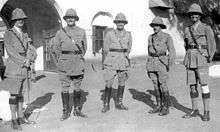
A conference held at Calicut presided over by the Zamorin of Calicut, the Ruler of Malabar issued a resolution:[37]
"That the conference views with indignation and sorrow the attempts made at various quarters by interested parties to ignore or minimise the crimes committed by the rebels such as: brutally dishonouring women, flaying people alive, wholesale slaughter of men, women, and children, burning alive entire families, forcibly converting people in thousands and slaying those who refused to get converted, throwing half-dead people into wells and leaving the victims to struggle for escape till finally released from their suffering by death, burning a great many and looting practically all Hindu and Christian houses in the disturbed areas in which even Moplah women and children took part and robbed women of even the garments on their bodies, in short reducing the whole non-Muslim population to abject destitution, cruelly insulting the religious sentiments of the Hindus by desecrating and destroying numerous temples in the disturbed areas, killing cows within the temple precincts putting their entrails on the holy image and hanging skulls on the walls and the roofs."
Rashtriya Swayamsevak Sangh was formed by K. B. Hedgewar in the aftermath of Hindu-Muslim riots during Khilafat Movement and particularly due to those during Moplah Riots. [38]
Wagon Tragedy
On 10 November 1921, when the uprising was near its end, almost 90 detained Muslim rioters were sent by train from Tirur to the Central Prison, Bellary in the Madras Presidency. During the return journey, 64 of the 100 prisoners suffocated to death in the closed railroad wagon.[39]
Statistics
| Name of Taluka | Muslim population (1921)[40] | Percent | Hindu population (1921)[40] | Percent |
|---|---|---|---|---|
| Calicut | 88,393 | 31 | 196,435 | 69 |
| Chirakkal | 87,337 | 77 | 25,498 | 23 |
| Cochin | 4,999 | 41 | 7,318 | 59 |
| Eranad | 237,402 | 59 | 163,328 | 41 |
| Kottayam | 55,146 | 24 | 175,048 | 76 |
| Kurumbranad | 96,463 | 27 | 259,799 | 73 |
| Palghat | 47,946 | 13 | 315,432 | 87 |
| Ponnani | 229,016 | 45 | 281,155 | 55 |
| Walluvanad | 133,919 | 34 | 259,979 | 66 |
| Wayanad | 14,252 | 17 | 67,845 | 83 |
| Total | 1,004,327 | 33 | 2,039,339 | 67 |
According to official records, the British government lost 43 troops with 126 wounded,[41] 10,000 Hindus killed by rebels, while 2337 rebels were killed, another 1652 injured and 45,40 imprisoned. Unofficial estimates put the number at [10] 50,00 imprisoned, of who 20,00 were deported (mainly to the penal colony in the Andaman Islands) while around 10,00 went missing.[11] The number of civilian casualties is estimated at between 10,000 and 12,000.[5]
Lord Curzon's statement in British parliament was that, "The Moplah rebellion is just over, but at least 2,500 Moplahs have been killed by our troops, at least 10,000 Hindus were murdered, and at least 1,000 more were forcibly converted to Mahommedanism. Temples and churches were defiled and damaged, and property to the value of £250,000 was destroyed."[42]
Sir William Vincent, who occupies the position of Home Secretary in the Legislative Council at Delhi. He recapitulates, almost as I have recapitulated, some of these statements, and this is a remarkable statement from Sir William Vincent, who should know better even than the right hon. Gentleman:Mr. Gandhi's supporters were responsible for the terrible loss of life in Malabar. The supporters of Mr. Gandhi, the friend of the right hon. Gentleman, the man who ought to have been locked up two or three years ago, and on the shoulders of the Government which refused to lock him up more than on Mr. Gandhi's shoulders himself are those 3,000 lives lost in Malabar."
Within five years subsequent to the conflict the agricultural output was averaging slightly more than prior to it. Qureshi has said that, "In short, contrary to popular belief, Malabar did not suffer massive devastation, and even if it did the recovery was miraculous."[43]
Popular culture
Renowned author Uroob's masterpiece novel Sundarikalum Sundaranmarum (The Beautiful and the Handsome) is set in the backdrops of Malabar Rebellion. The novel has about thirty characters belonging to three generations of eight families belonging to Malabar during the end of the Second World War. Sundarikalum Sundaranmarum won the Kendra Sahitya Akademi Award, India's most prestigious literary award, in 1960. It also received the Asan Centenary Award in 1973, a special award given by the Kerala Sahitya Akademi for the most outstanding work since Independence.
The 1988 Malayalam language film 1921 or Ayirathi Thollayirathi Irupathonnu (English title: Nineteen Twenty One), directed by I. V. Sasi and written by T. Damodaran, depicts the events of the rebellion. The film stars Mammootty as Khadir, a retired Mappila soldier, alongside Madhu as Ali Musliyar. The film won the Kerala State Film Award for Best Film with Popular Appeal and Aesthetic Value in the same year.[44]
The rebellion also spawned a large number of Mappila Songs.[45] Many of these describe the events surrounding the Khilafat movement in Malabar and offer a view of conditions in the area at the time. Ahmed Kutty composed the Malabar Lahala Enna Khilafat Patt in 1925, which describes the events of the rebellion. Many of rebel prisoners such as Tannirkode Ossankoya composed songs in their letters to relatives.[46]
Monuments

The officers and men from the Dorset Regiment who lost their lives while taking part in the suppression of the revolt are commemorated in a brass tablet at the St. Mark's Cathedral, Bangalore.[47]
The Variyankunnath Kunjahammad Haji Memorial Town Hall in Malappuram Municipality[48] is named after the leader of the rebellion, while the Tirur Wagon Tragedy Memorial Town Hall commemorates the eponymous incident.[49] The Pookkottur War Memorial Gate is dedicated to those killed in the Pookkottur battle.[50][51]
Along with these monuments, abandoned graves of British officers who lost their lives during the rebellion can be seen in Malabar. This includes that of Private F. M. Eley, Private H. C. Hutchings (both died of wounds received in action against the Mappilas at Tirurangadi on 22 July 1921), William John Duncan Rowley (Assistant Suprededent of Police, Palghat, killed at Tirurangadi by a mob of Mappilas at the outbreak of the rebellion on 20 August 1921 – aged 28).
See also
- Persecution of Hindus
- Murder of Collector Connolly
- Khilafat
- Anti-Hinduism
- Malabar Special Police
- Freeman Freeman-Thomas, 1st Marquess of Willingdon
- John Burnett-Stuart
- Dorset Regiment
- Mappila riots
References
- "Resurrecting a forgotten freedom fighter". www.thehindu.com. 8 October 2016. Retrieved 8 July 2020.
- K. Madhavan Nair. Malabar Kalapam (2016 ed.). Mathrubhumi Books. p. 207. ISBN 9788182666115.
- https://www.thenewsminute.com/article/variyamkunnath-and-nuances-malabar-rebellion-author-manu-s-pillai-interview-127217
- "Khilafat movement". Encyclopedia Britannica. Retrieved 9 October 2017.
- Pg 447, Pan-Islam in British Indian politics: a study of the Khilafat Movement, 1918–1924 M. Naeem Qureshi BRILL, 1999
- Pg 179–183, Kerala district gazetteers: Volume 4 Kerala (India), A. Sreedhara Menon, Superintendent of Govt. Presses https://books.google.com/books?id=ZF0bAAAAIAAJ
- Page 622 , Peasant Struggles in India, AR Desai, Oxford University Press – 1979
- http://www.kerala.gov.in -> History -> Malabar Rebellion
- Pg 58, The Mappilla Rebellion, 1921: Peasant Revolt in Malabar, Robert L. Hardgrave, Modern Asian Studies, Vol. 11, No. 1 (1977), Cambridge University Press
- Pg 361, A short survey of Kerala History, A. Sreedhara Menon, Vishwanathan Publishers 2006
- Pg 45, Malabar: Desheeyathayude idapedalukal ( Malabar: involvement of nationalism), MT Ansari, DC Books
- K. N. Panikkar, Economic and Political Weekly, Vol. 17, No. 20 (15 May 1982), pp. 823–824
- Pg 67, The labor of development: workers and the transformation of capitalism in Kerala, India, Patrick Heller, Cornell University Press, 1999
- Kupferschmidt, Uri M. (1 January 1987). The Supreme Muslim Council: Islam Under the British Mandate for Palestine. BRILL. ISBN 978-9004079298. Retrieved 25 April 2017 – via Google Books.
- EncyclopaediaDictionaryIslamMuslimWorld Volume 6. 1988. p. 460.
Contemporary evaluation within India tends to the view that the Malabar Rebellion was a war of liberation, and in 1971 the Kerala Government granted the remaining active participants in the revolt the accolade of Ayagi, "freedom fighter"
- https://hindugenocide.com/islamic-jihad/moplah-hindu-genocide-1921-2500-hindus-slaughtered-26k-refugees/
- https://indictales.com/2019/11/20/the-moplah-genocide-of-hindus-an-eternal-reminder-sandeep-balakrishna-malabar-riot/
- Pg 80 Modern Kerala: studies in social and agrarian relations, K. K. N. Kurup, Mittal Publications, 1988
- Pg 17–20, Peasant Struggles, Land Reforms and Social Change: Malabar 1836–1982 By P Radhakrishnan – COOPERJAL
- Pg 1- 24, Tenancy legislation in Malabar, 1880–1970: an historical analysis , V. V. Kunhi Krishnan (Ph.D Thesis under Dr. K. K. N. Kurup, Calicut University ), Northern Book Centre, 1993
- Pg 53, Kerala Development Report, Government of India Planning Commission, Academic Foundation, 2008
- Logan, 1951b:209-10.
- Mazumdar, 1973; Ravindran, 1973; Dale, 1980.
- Houtart and Lemercinier, 1978; Namboodiripad, 1943:1–2; Panikkar. 1979:611; Wood, 1974.
- Nair, C. Gopalan (1923). The Moplah Rebellion, 1921. Calicut: Norman Printing Bureau. pp. 7–8.
- Gopalan Nair, Diwan Bahadur (1922). Moplah Rebellion , 1921. https://archive.org/stream/MoplahRebellion1921/Moplah%20rebellion,%201921_djvu.txt: Norman Printing Bureau. p. 8.CS1 maint: location (link)
- King (19 November 1935). "Madras High Court". Retrieved 11 August 2019.
- Telegram No. 687, dated 8-11-1921 in G. Tottenham (ed.), The Malabar Rebellion 1921-1920. Chennai. 1922. p. 173.
- Roland E. Miller, Mappila Muslims of Kerala: A Study in Islamic Trends. Chennai. 1992. p. 148.
- "Paramban Mammadu And Ors. vs The King on 19 January, 1949". indiankanoon.org. Retrieved 21 July 2019.
- O P Ralhan (1996). Encyclopaedia of Political Parties: India, Pakistan, Bangladesh: National, Regional, Local. Anmol Publications PVT. LTD. p. 297.
- Ambedkar, Bhimrao. Pakistan or the Partition of India. pp. Chapter 6.
- Nair, C. Sankaran. "MALABAR’S AGONY." Annie Beasant. New India. Quoted in "GANDHI AND ANARCHY.". pp. 133–6.
- Gundappa, D.V.; et al. (December 1922 – January 1922). INDIAN REVIEW OF REVIEWS. p. 213.
- Shraddanand, Swami (26 August 1926). "The Liberator".
- Nair, Sankaran (1995). Gandhi and Anarchy. Mittal Publications. pp. 45–47.
- Majumdar, Ramesh Chandra (1 January 1977). "History of the Freedom Movement in India". Firma K. L. Mukhopadhyay. Retrieved 25 April 2017 – via Google Books.
- https://scroll.in/article/881894/a-great-son-of-mother-india-heres-what-rss-founder-kb-hedgewar-said-about-muslims
- "64 out of 100 Moplah prisoners suffocated in a closed car on train in India" (PDF). The New York Times. The New York Times. 22 November 1921. Retrieved 6 January 2020.
- Sreevidhya Vattarambath. The Rebillion (PDF). Department of History, University of Calicut,. p. 7. Retrieved 8 July 2020.CS1 maint: extra punctuation (link)
- Pg 20, Papers by command: Volume 16 , Great Britain. Parliament. House of Commons – 1922
- "INDIA. (Hansard, 14 February 1922)". api.parliament.uk. Retrieved 21 July 2019.
- Qureshi, M. Naeem (1999). Pan-Islam in British Indian politics: a study of the Khilafat Movement, 1918–1924. BRILL. p. 454. ISBN 9789004113718.
- "official website of INFORMATION AND PUBLIC RELATION DEPARTMENT OF KERALA". Kerala.gov.in. Archived from the original on 3 March 2016. Retrieved 25 April 2017.
- Pg 452, Asian journal of social science, Volume 35, Issues 1–5, Brill, 2007
- Congress, South Indian History (1 January 1988). "Proceedings of the ... Annual Conference ..." The Congress. Retrieved 25 April 2017 – via Google Books.
- David, Stephen (9 January 2009). "200 years of Bangalore's oldest Christian landmark". India Today. Retrieved 27 January 2015.
- "The Hindu : Engagements / Palakkad : In Palakkad Today". HinduOnNet.com. Retrieved 25 April 2017.
- "Places to visit". Archived from the original on 4 February 2012. Retrieved 26 April 2010.
- "Battle of Pookottur commemorated". The Hindu. Chennai, India. 27 August 2009.
- "Pookkottur Grama Panchayat". lsgkerala.in. Retrieved 25 April 2017.